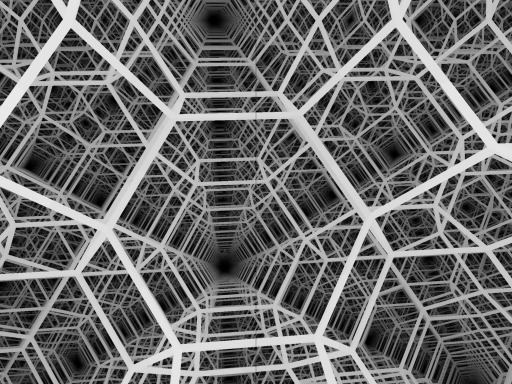 | ||
The bitruncated cubic honeycomb is a space-filling tessellation (or honeycomb) in Euclidean 3-space made up of truncated octahedra (or, equivalently, bitruncated cubes). It has 4 truncated octahedra around each vertex. Being composed entirely of truncated octahedra, it is cell-transitive. It is also edge-transitive, with 2 hexagons and one square on each edge, and vertex-transitive. It is one of 28 uniform honeycombs.
Contents
John Horton Conway calls this honeycomb a truncated octahedrille in his Architectonic and catoptric tessellation list, with its dual called an oblate tetrahedrille, also called a disphenoid tetrahedral honeycomb. Although a regular tetrahedron can not tessellate space alone, this dual has identical disphenoid tetrahedron cells with isosceles triangle faces.
Geometry
It can be realized as the Voronoi tessellation of the body-centred cubic lattice. Lord Kelvin conjectured that a variant of the bitruncated cubic honeycomb (with curved faces and edges, but the same combinatorial structure) is the optimal soap bubble foam. However, the Weaire–Phelan structure is a less symmetrical, but more efficient, foam of soap bubbles.
The honeycomb represents the permutohedron tessellation for 3-space. The coordinates of the vertices for one octahedron represent a hyperplane of integers in 4-space, specifically permutations of (1,2,3,4). The tessellation is formed by translated copies within the hyperplane.
The tessellation is the highest tessellation of parallelohedrons in 3-space.
Symmetry
The vertex figure for this honeycomb is a disphenoid tetrahedron, and it is also the Goursat tetrahedron (fundamental domain) for the
Related polyhedra and honeycombs
The [4,3,4], , Coxeter group generates 15 permutations of uniform tessellations, 9 with distinct geometry including the alternated cubic honeycomb. The expanded cubic honeycomb (also known as the runcinated tesseractic honeycomb) is geometrically identical to the cubic honeycomb.
The [4,31,1], , Coxeter group generates 9 permutations of uniform tessellations, 4 with distinct geometry including the alternated cubic honeycomb.
This honeycomb is one of five distinct uniform honeycombs constructed by the
Projection by folding
The bitruncated cubic honeycomb can be orthogonally projected into the planar truncated square tiling by a geometric folding operation that maps two pairs of mirrors into each other. The projection of the bitruncated cubic honeycomb creating two offset copies of the truncated square tiling vertex arrangement of the plane:
Alternated form
This honeycomb can be alternated, creating regular icosahedron from the truncated octahedra with irregular tetrahedral cells created in the gaps. There are three constructions from three related Coxeter-Dynkin diagrams: , , and . These have symmetry [4,3+,4], [4,(31,1)+] and [3[4]]+ respectively. The first and last symmetry can be doubled as [[4,3+,4]] and [[3[4]]]+.
This honeycomb is represented in the boron atoms of the α-rhombihedral crystal. The centers of the icosahedra are located at the fcc positions of the lattice.
